The “Secret” to Successful Deep Drop Fishing Trips in the Florida Keys
When our customers mention deep drop fishing or deep dropping, they are often referring to swordfishing. Although a Swordfish is an incredible trophy and great to eat, many other creatures of the deep are also fun to catch and delicious to eat. At Main Attraction, we consider fishing for any species in depths over 500 feet to be deep dropping.
This will be the 6th installment of our “Secrets To Success” article series. We sat down with Captain Marty Lewis, who runs our 49′ flagship, the Main One, and asked him about his deep dropping techniques. This article is comprised of mostly Captain Marty’s answers based on first-hand experience. The information herein is based on observations and recollections from deep dropping charters we have run in the Atlantic ocean, south of the Marathon, Florida Keys. This article is in no way a legal guideline on which fish can be harvested or not. Harvest rules often change, so always check local fishing regulations for the location you plan to fish (here for the Keys). We hope you enjoy this new format and look forward to your feedback!
What can you catch deep drop fishing in the Florida keys?
Yellowedge Grouper, Snowy Grouper, Barrelfish, Blackbelly Rosefish, Queen Snapper, Blueline Tilefish, Golden Tilefish, and Swordfish. That is just a few there are more, when you drop a bait in the ocean the possibilities are endless. That is why saltwater fishing is so exciting.
When is the best trip to book if I want to catch a swordfish?
We recommend booking a minimum of a seven hour charter for deep dropping as some of our spots are 25+ miles offshore. When targeting Swordfish, you need to book a 10-hour charter as the fishing grounds are 30+ miles offshore. We often can catch other fish on the way, such as Mahi or Tuna, so allowing time for that is wise. When it comes to Swordfishing, one drift can take 45 minutes or so, and there is no guarantee that the drift will be a success. Also, once you hook a Swordfish, you have to factor in fighting time which could be a while depending on the size.
Are Florida Keys deep drop fish good to eat?
Absolutely! The fish I just listed before are some of the highest quality fish you could ever hope to eat! Perhaps it is the low light, oxygen levels, or the colder water temperature, but there is something special about eating deep-water fish. The meat is generally very mild and not too “fishy” tasting. The texture of the meat depends entirely on the species; some are firmer and denser, others are lighter and flakier, but all of them are delicious. In my experience, deep-water fish keep very well in the freezer as long as the bloodline is removed before freezing. Before putting filets in the freezer, we recommend vacuum-sealing them while they are fresh to help preserve the meat’s best quality.
What gear do I need to catch deep-water fish in the Florida Keys?
We use electric reels to get the baits up and down quicker, although once a fish is on, if you prefer to hand crank the line, our electric reels give you both options. When dropping anywhere from 600-1800 feet deep, you want to have the motorized option! The Daiwa Tanacom is a popular lower-cost electric reel option that can get the job done. We use those reels to retrieve our fishing Kites. That being said, we fish Penn Hooker Electric Reels almost exclusively.
How do you rig for general deep-dropping?
For deep dropping, I use “chicken rigs,” a leader with three to six circle hooks depending on the size of fish I am targeting. I tend to use fewer hooks for larger fish like Grouper. A few glow beads, a bait skirt, and flashing lights help attract the fish. I use all sorts of bait such as squid and chunks of fish, preferably something with a shine like a Bonita or Barracuda. The lead sinker is 5-10lbs and connected at the very end of the line.

How do you rig for Swordfish?
I use a similar concept for the general deep drop approach but with a single hook. The terminal tackle, in general, is much heavier than the chicken rig. I use a 300 lb. mono leader. I also use a lead sinker weighing 15-20 lbs. connected 150-175 ft. above the bait.
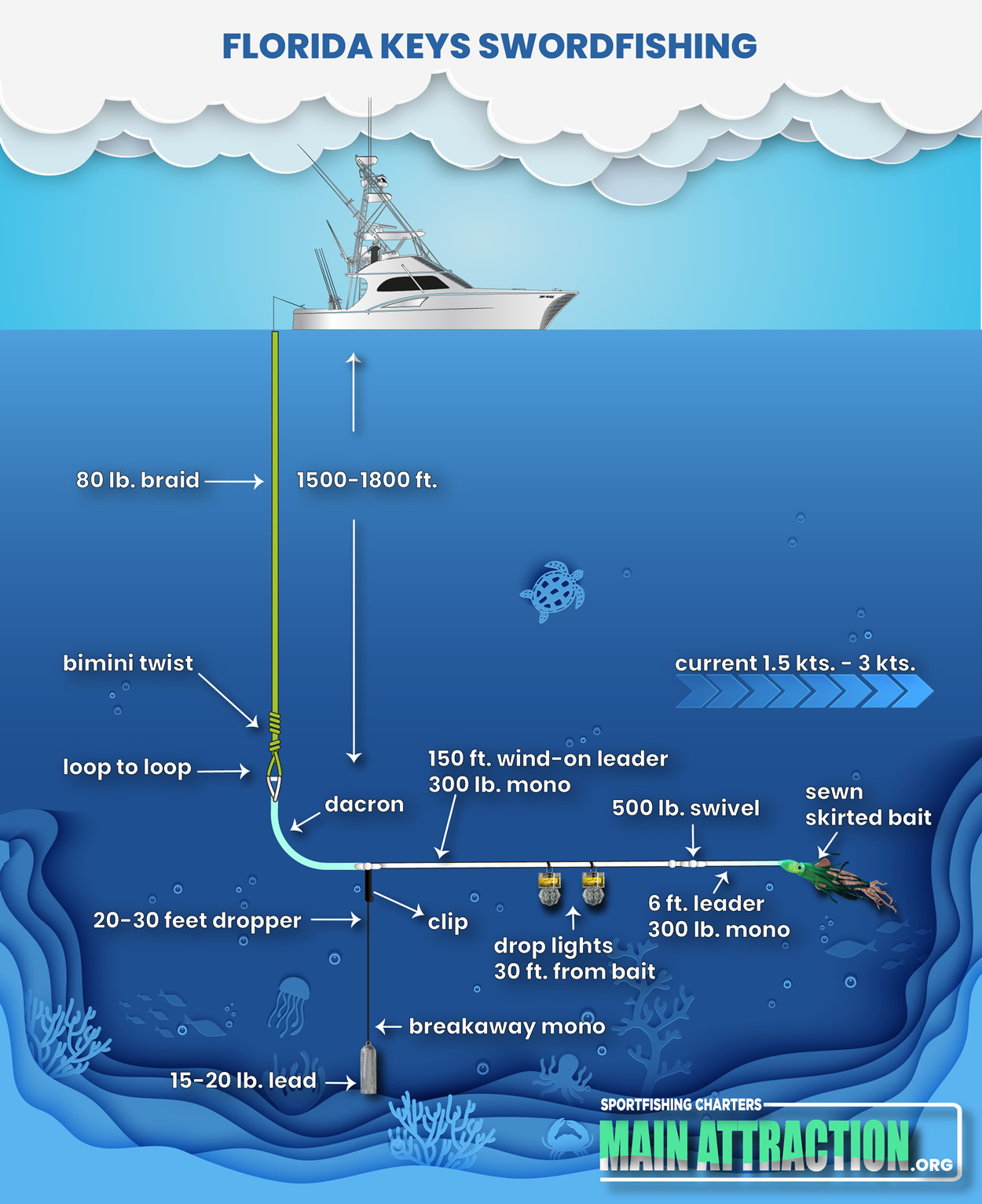
How do you find fish?
Depending on what I target, the depths I fish will range from 600 feet up to 1800 feet for Swordfish. The fish that the Seafloor holds at any given location depends on several factors and which species is involved. We use bottom machines or fish finders to emit a sonar signal that bounces off the bottom. This allows us to find specific structures or seabed types that can hold fish.

Captain Marty uses sonar to locate fish and structure that holds fish at varying depths.
What time of year does deep-dropping work the best?
Deep dropping can work year-round if the conditions are right. That being said, most deep drop species are in season for harvest in the summertime. Also, the summer months in the Florida Keys typically come with calmer weather which is generally better for deep dropping. The lower summer winds bring calm days and not too much current, the ideal deep dropping conditions.
I often add deep dropping to an offshore Mahi or Tuna trip in the summertime because I am already fishing in that same area. If the conditions look right, I will tell my mate to grab the deep drop rod and reel and get rigged up. When he hears that, he knows we are going to make a pass and try to put a different species in the boat.
Sometimes deep dropping is a great option when the Mahi fishing is slow. When the water looks like glass, we say it’s slick. When it’s slick out there with very little wind, the Dolphinfish often seem harder to find, or when you do find them, they aren’t eating like they usually would. Deep dropping comes to the rescue when the pelagic fish are scarce or lethargic.
What are the ideal conditions for deep dropping?
Well, as I said earlier, calm days for the most part. But also you want some current, but not too much! You want to drift with your baits in the current on or near the bottom.
How do you catch all of these different species of fish?
Experience is helpful because the more you go out there, the better you get. It just becomes second nature if you fish seven days a week for decades like I have. If I see something interesting on the bottom machine while catching something else, I mark it and check it out later. After a while, you just get a feel for it, and it becomes easier to succeed.
Can you break down the differences between the species you deep drop for?
Snowy Grouper
Well, I guess I will start with Snowy Grouper since it is one of the better eating bottom fish targets; it is always exciting when we catch one. We find them in holes, trenches, ledges, and humps. We catch them on our chicken rigs with Squid or Bonita for bait. We usually find them in depths of 500-800 feet. The limit on Snowy Grouper is one per vessel in the waters we catch them in. They also count toward the three grouper per angler aggregate bag limit.
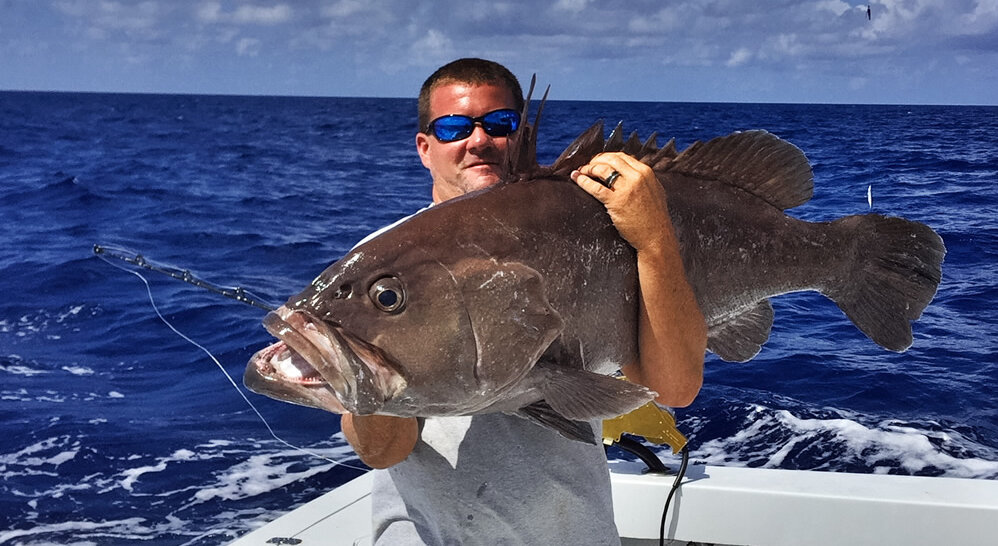
Captain Marty Lewis holding a large Snowy Grouper.
Yellow Edge or Yellowfin Grouper
Yellow Edge groupers taste even better than Snowies, and we are also allowed three per person as long as they are over twenty inches and comply with the aggregate limit. It might be the best tasting of all the Grouper, I always love it when we catch them. I catch Yellowedge Grouper on the chicken rig in 600-630 feet on smaller shallow humps.
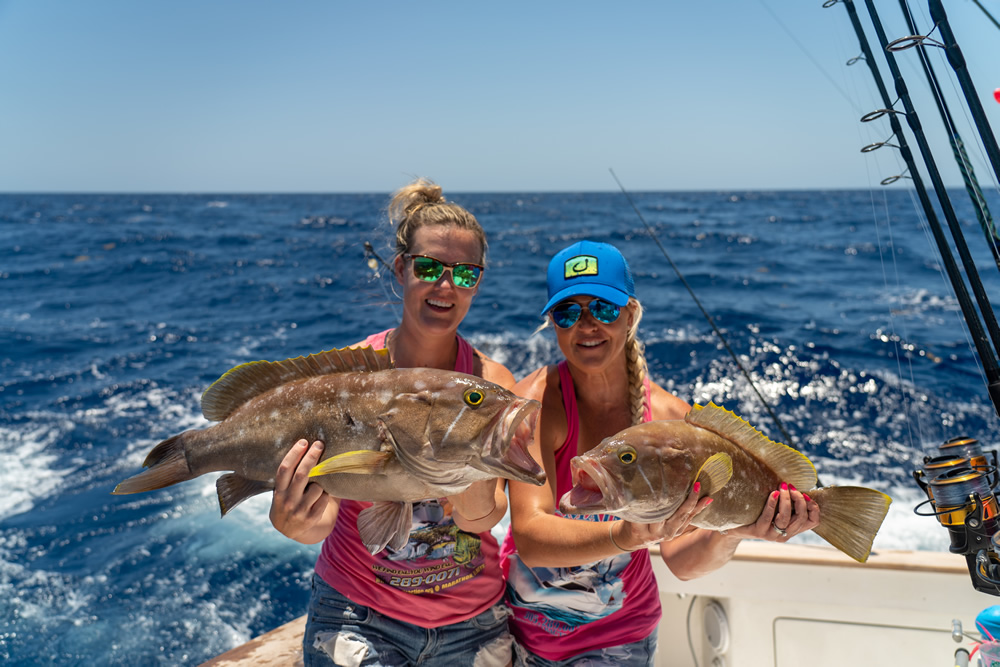
Katie Lewis and Elise Mucha hold up a pair of Yellowedge Groupers.
Blackbelly Rosefish
Rosies are a deep dropping blessing because they are delicious and plentiful. They can be found all over in the 800-1150 foot range of depth. We often catch them when targeting something a bit bigger, but they are a helluva consolation prize! They look like a Grouper and Scorpion fish had babies, but what they lack in looks, they make up in flavor! There is currently no limit or minimum on these, so you can catch as many as you want.
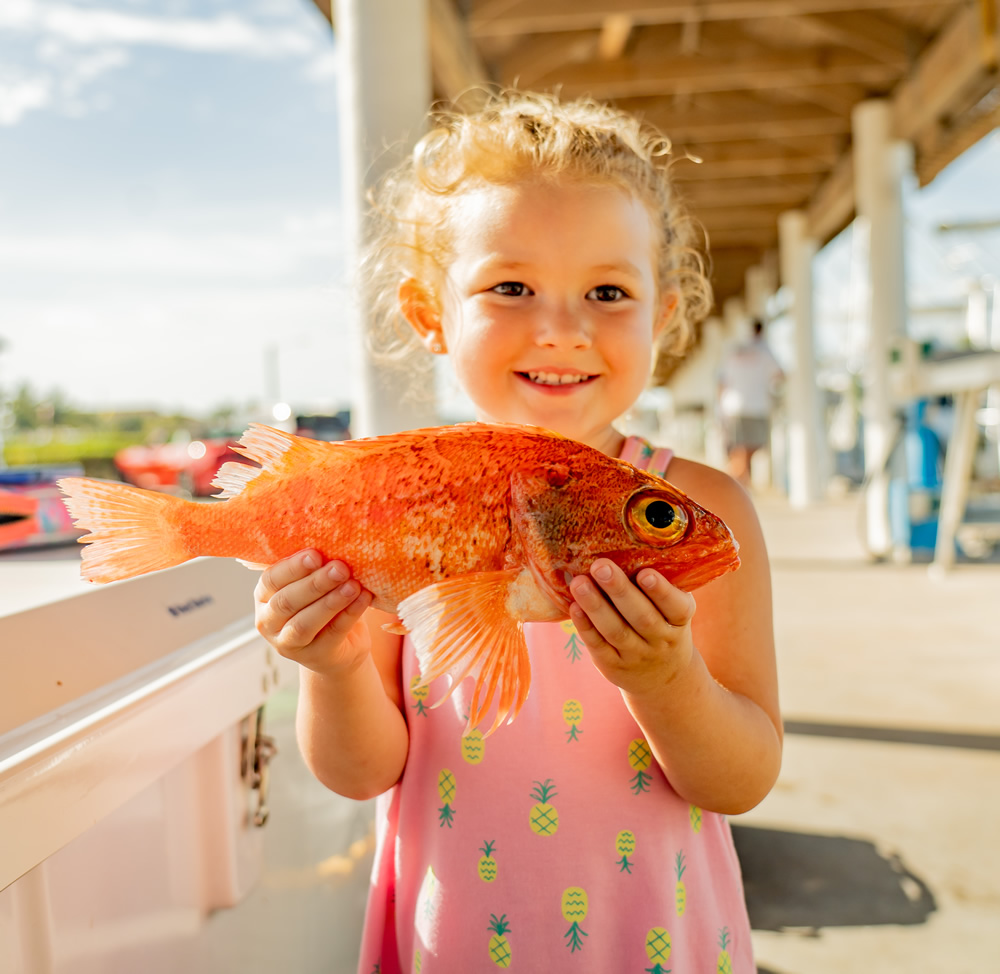
Natalie Lewis with a Blackbelly Rose Fish.
Queen Snapper
They truly are the Queens of the Snapper. These fish are stunning and take amazing photos with their bright red colors. We catch the larger ones near the bottom on or around ledges and trenches, usually in the 600-1000 foot range. The limit is 10 per angler, which is plenty for any angler. Oh, and these are fantastic eating. We use squid and cut fish to catch them on a chicken rig.

The Lewis clan with a beautiful Queen Snapper.
Barrelfish
There seems to be a bit of mystery around the Barrelfish. For one, it is not the easiest fish to find or consistently target, which is why Barrelfish aren’t fished for commercially. We do catch them, though; our clients are fascinated by them. I catch them near ledges, humps, and holes in 800-1150 feet of water. Barrels have a firm flesh and mild flavor; many think they taste more like chicken than fish! They have a heavy slime coating covering their body, so be sure to clean up after they drip it all over the deck.

Mate Alex Lewis holds up a Barrelfish caught aboard the Main One.
Golden and Blueline Tilefish
Suppose you have no fishing spots and are out in 500-1000 feet of water. In that case, you might want to try dropping a bait to the bottom in the middle of nowhere. If the current is right and your bait is on the bottom, you will probably eventually hook a tilefish if you drift for long enough.
Unlike many other deep drop fish, these tend to hide in muddy bottoms. So instead of looking for structures, ledges, and caves, you are looking for more of a flat bottom, which isn’t difficult. You may or may not mark these fish with the sonar as they tend to burrow and hide in the mud. When you catch one, it’s best to mark the location on your GPS because chances are you can catch more there. Just be careful and check the regulations because in the waters we fish, both Golden and Blueline Tilefish count towards that three fish Grouper aggregate limit. The seasons and harvest limits are different between the two tilefish, so check local laws.
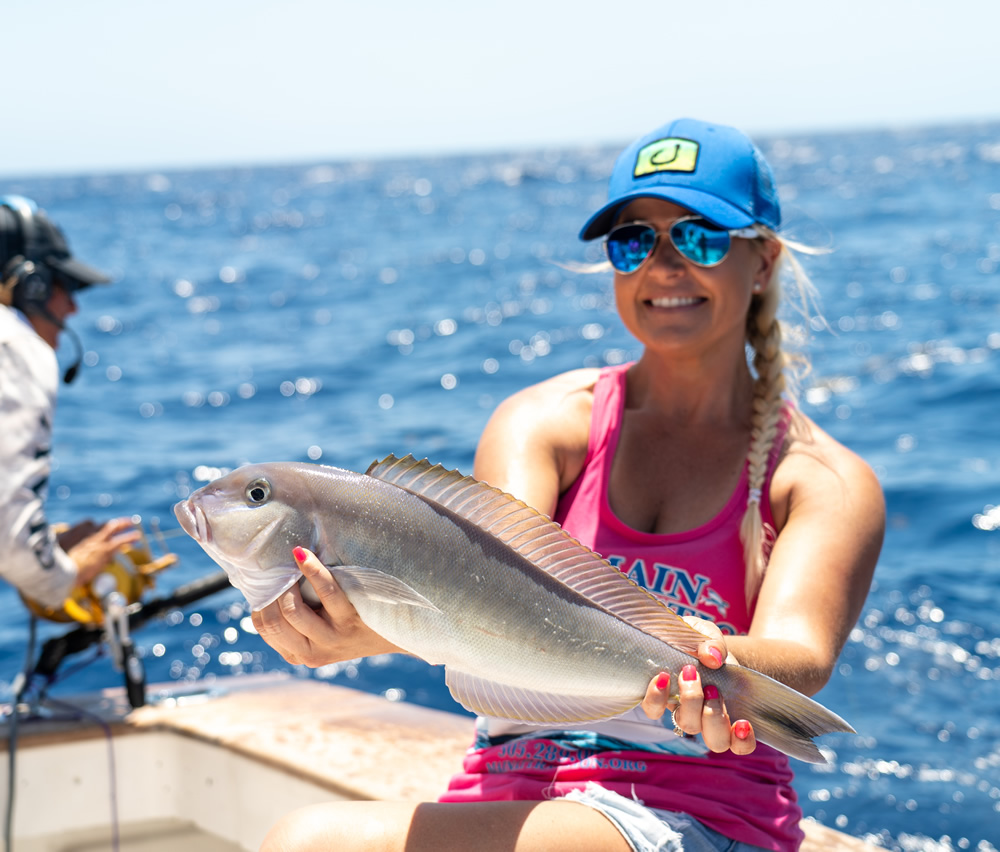
Katie Lewis holds up a Blueline Tilefish caught deep dropping on her birthday.
Swordfish
Swords are the pinnacle of deep drop fishing accomplishment. Catching a swordfish takes a lot of skill, the right conditions, and even a little luck. I use eels, dolphin bellies, bonita bellies, barracuda, and squid for bait. We sew each Swordfish bait together so it can withstand the sword-bashing it will receive before being eaten. After a successful hookup, it can take hours, depending on how many hundreds of pounds your fish weighs and where it is hooked.
For daytime swordfishing, I target them near the bottom in depths of 1500-1800 feet, where they are constantly feeding throughout the day. Fortunately, we have the technology to help us. Without it, it might take days to reel a giant swordfish in! Hooking a swordfish is half the battle. Getting it to the surface is another. Swordfish have notoriously soft mouths, which means they are easy to lose if the hook tears out, and it often does. Even getting the fish in the boat is challenging. Swordfish freak out when they feel the point of the gaff, and it usually takes several to get control of the fish. Depending on the size, we might even need to use a harpoon.
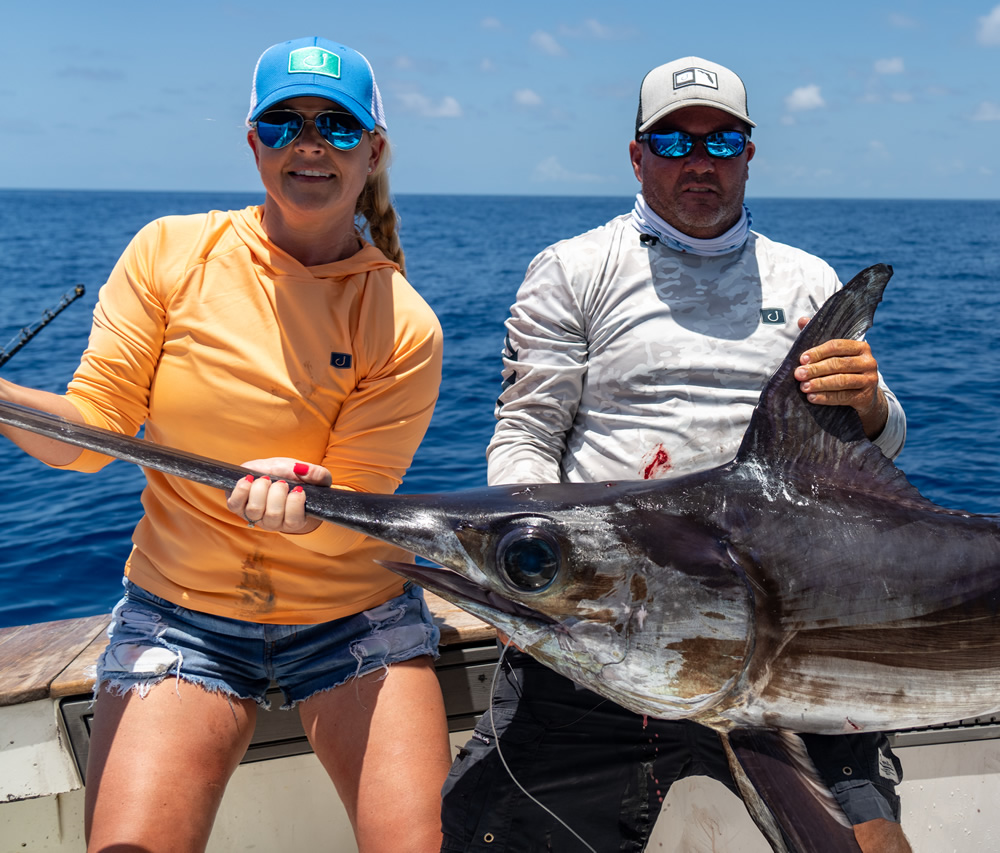
Main Attraction Owners Katie and Marty Lewis with a Swordfish caught in over 1500 feet of water.
Are there any rare fish that you catch deep dropping?
Misty Grouper
Misty Grouper fit in the same category as Yellow Edge but aren’t as good to eat. They are a less common catch in the Keys, but we do catch them. A misty grouper looks similar to a yellow edge without the yellow bits. Much like Yellowedge Grouper, you can harvest one per angler, which counts toward your three grouper aggregate limit per angler.
Escolar
In my opinion, you should throw these back. They are incredibly oily fish, and while their meat tastes delicious, it gives most people the runs, and it simply isn’t worth it. If you have ever eaten “white tuna” on a sushi menu and fared well, maybe Escolar is for you. Personally, I will pass.
Yellow Eye Snapper
These fish taste like the other snappers we catch, such as Vermillion, Yellowtail, and Mangrove. So they are good eating, but not a common catch or target for us. When they do come up from the deep, we aren’t complaining.
What is the secret to successfully deep dropping in the Florida Keys?
Well, preparation helps a lot. Have baits sewn and ready to go, your rigs made, spare leads, and drop lights. You want to make sure if you lose a rig, you can redeploy a bait quickly to be fishing again.
You also want to observe the results of your experiments so you learn. If you catch a fish, mark where on your GPS, and watch the fish finder. What did you see on the bottom finder? Is there a hole or a hump there? Did you mark fish before the bite? Ask yourself what direction the current is moving in, the water temperature, and which way the wind is blowing. Take note of how your vessel is drifting and the speed and direction of the current.
Most importantly, you need to have patience. You need to put in the time to get the bite, especially with Swordfishing. That means fishing often, trying different things, and taking note of the results. I would say the “secret” is three-fold, preparation, patience, and observation.
Conclusion
That concludes our interview with special thanks to Captain Marty for making time to answer our questions. We hope you enjoyed this article and the video, and maybe even learned something. If you wish to read more about Swordfish check out our recently published Swordfish article and video. We also have a great Barrelfish article and video, and a Queen Snapper article and video. If you are interested in fishing offshore with Captain Marty or any of our other skilled Captains, reach us at (305) 289-0071 or visit our contact page.




